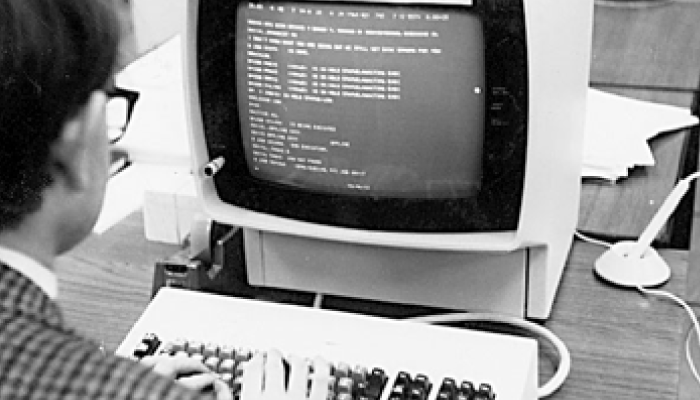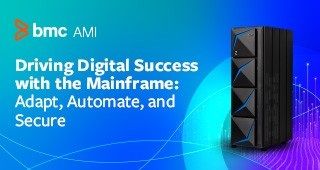
“A long time ago, in a galaxy far, far away…” the powers that be decided that the standard user interface (UI) for our beloved mainframe would be a rectangular screen 80 characters wide by 24 lines high. Thanks to the abundance of monochrome cathode ray tubes (CRTs) using P1 phosphor, the term “green screen” was born.1
Admittedly, it was nice when color CRTs were introduced, enabling color changes for each character as appropriate for the application. But it did nothing to increase the available screen real estate, which was still limited to 80 x 24. Nor did it help with data entry methods, which remained limited to the keyboard. Given IBM’s hardware dominance at the time, green screens were also referred to as a “3270,” which was the model number of a popular non-graphical, dumb-terminal display that IBM introduced in the early 1970s.
For many years to come, this basic but functional UI was the accepted norm for online mainframe-based applications using transaction processing (TP) monitors, such as Customer Information Control Systems (CICS) and Information Management System (IMS). In addition, independent software vendors (ISVs) used it as a palette to develop products for IT professionals, such as developers, database administrators (DBAs), and systems programmers. In fact, some IT professionals measured proficiency by how well you could navigate your way around common green-screen products, such as Time Sharing Option (TSO), Interactive System Productivity Facility (ISPF), System Display and Search Facility (SDSF), etc.
Sometime around the mid to late ‘90s, when distributed technology began to take root as a viable alternative, Mainframers were introduced to a new UI known as the “graphical user interface,” or GUI. The GUI was the norm for distributed-based applications and ISV tools and it was not limited to 80 x 24 characters. It offered much more screen real estate and permitted displays of virtually any text or image. Naturally, there was spirited debate over the need for a GUI. Many mainframe IT professionals proclaimed there was no such need and that they would hold onto the green screens with a death grip.
Fast forward to 2016, possibly with a jump to light speed through hyperspace, and we have personal computers, mobile phones, tablets, and all are essential components of business and everyday life. In fact, you’d have as much luck getting me to relinquish my iPhone as getting Luke Skywalker to give up his light saber. The applications on all those devices run on many different operating systems and all of them use GUIs. And not just any UIs – the expectation today is that minimum viable product must include an intuitive, modern, sleek user interface that delights and inspires users. Wow, how’s that for a shift? Today, the single biggest exception to widespread use of a graphical user interface is the ISV applications running on the z/OS platform. For whatever reason, the green screen has remained the UI of choice on z/OS for over 40 years. But that is changing.
Today the mainframe remains as strong and viable a business platform as ever, but the folks who operate it are getting a bit older. As the baby-boomer centric, z/OS workforce enters retirement age, their skill sets do too—including how to use the green-screen UI. Businesses will replace retirees with millennials who have no clue and absolutely no desire to learn the archaic green-screen UI. After all, they’ve used nothing but GUIs since they touched their first smartphone, Xbox, or Macbook. With 3840×2160 4k displays widely available, forcing them into 80×24 is just not going to work, ever.
Enter BMC Workbench for DB2
In response to this trend and in keeping with our commitment to innovating on the mainframe, BMC took on the challenge of creating a new UI that would provide DBAs, application developers, and system programmers modern and mobile access to the mainframe. From the beginning in 2013 when BMC launched the first version of a GUI-based workbench for developers, to now in 2016, we have continually updated and advanced the product and have a new way to work. With BMC Workbench for DB2, DBAs have a new way to manage their z/OS-based DB2 database environments.
Workbench for DB2 uses a modern web-based interface that allows application developers and DBAs to access the DB2 catalog information they need to support DB2 application development. Instead of requiring knowledge of how to use TSO/ISPF and navigate the internals of DB2, the application developer or DBA can use an intuitive, familiar web-based interface, which presents information in a typical, non-mainframe paradigm. It retains all the mainframe access security and restrictions, including the mainframe logon and password. It observes all of the DB2 access privileges that have been defined for the logon credentials. Architecturally, Workbench for DB2 is completely mainframe-based. There is no client to install and DB2 Connect is not required. Access is provided via a web server.
Workbench for DB2 supports those tasks performed most frequently by developers and DBAs in their everyday activities.
Here’s a high-level summary of the functionality provided with BMC’s Workbench for DB2:
- DB2 catalog navigation honoring existing DB2 security privileges
- Generation and execution of common commands – DDL/DCL/HDDL/STOP/START/DISPLAY/DROP
- SQL tuning using expert system rules to highlight performance issues and/or best-practice violations
- Visual description of EXPLAINed SQL statements
- Generation of BIND/REBIND/FREE commands
- WHAT-IF statement change and statement COMPARE
- File locator (to access/update/create z/OS datasets – similar to ISPF 3.4)
- Job browser (to view your executing and spooled job output – similar to SDSF, IOF, etc)
- Scratchpad (from which you can display/edit/execute DDL, JCL, DB2 commands)
- WHAT-IF index feature that enables you to evaluate the potential performance of an SQL statement by creating an index, dropping an index, or updating index statistics.
- Overarching “workspace” paradigm, which allows users to define, save, and share a collection of objects related to the work they are performing so they can quickly resume their work, exactly where they left it.
Our Galaxy Today
IBM’s System/S360 line is now over 50 years old. Obviously, technology has improved dramatically since then and become critical to our everyday lives. Interestingly, as consumers, all of our access to technology is through a GUI, whether it’s sending a text message, using an ATM, or paying bills online. Steve Jobs and Apple also raised the bar – minimal apps with flashing green characters on a black screen will not work for today’s end users or database professionals. The expectation of the tools you work with every day as a professional is the same for those you use in your real life – delight and awe, extreme ease of use and intuitiveness.
As much of the z/OS workforce nears retirement age, the mainframe remains a vibrant and strong platform for digital business and skills will need to be passed down to the next generation of database professionals that has known nothing but GUIs. BMC’s Workbench for DB2 is the browser-based alternative for the DB2 z/OS professional to perform everyday DB2 activities, regardless of whether you are an “old-school” mainframer or a z/OS newbie. Workbench is the innovation/advancement you need to bridge the gap. Provide your up-and-coming DBAs with the tools (or workbench) they need to be successful on the mainframe. Make the shift; you’ll need to – and may the force be with you.
For more information on BMC’s Workbench for DB2, please see: http://www.bmc.com/it-solutions/workbench-db2.html
1 The amber, P3 phosphor was popular for a while in the 1990s.↩







